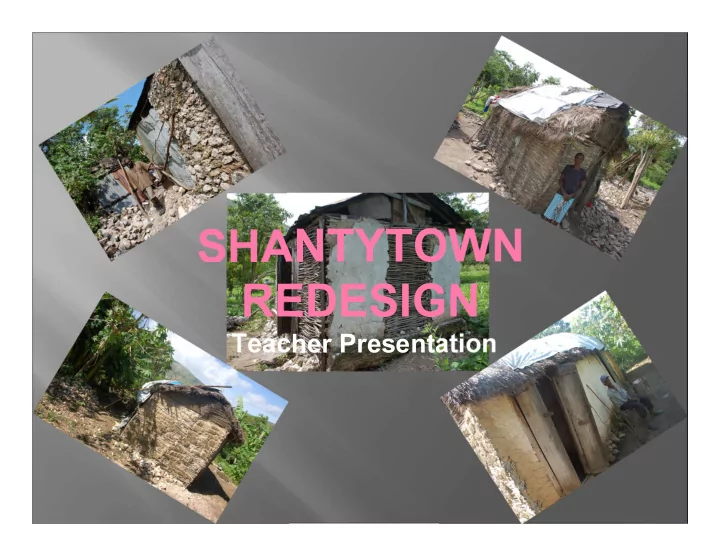

SHANTYTOWN REDESIGN Teacher Presentation
Intro to STEM Education ● Integrated Problem-Based Learning: ● Solving real-world problems through engineering Habits of Mind ● Your challenge: ● Integrate information you’ve already learned ● Read and analyze new information ● Research and ask questions; recognize all of your resources ● Try various strategies—think creatively and critically ● Discuss, design, explain, iterate
Engineering Design Process
Questions to Consider An important part of Consider the following questions as we look at the next couple of slides: ● What do you notice in these pictures? ● What questions do these images raise? ● What does that make you wonder about? ● What do we need to find out in order to solve any problems we see? ● What do you feel is absent in this picture? How would we find that out? What specifically do you want to ask these people?
2016 Al Jazeera, “Horrors left by Hurricane Matthew become clear in Haiti” http://www.aljazeera.com/news/2016/10/horrors-left-hurricane-matthew-clear-haiti- 161008094813244.html
2016 United Nations (Logan Abassi), “Haiti hit by Hurricane Matthew” https://www.flickr.com/photos/un_photo/31569587301/in/album-72157674071957903/
2016 CDC Global (Avi Hakim), “Moron, Haiti after Hurricane Matthew” https://www.flickr.com/photos/89075068@N07/31018500283
2016 CDC Global (Coralie Giese), Damage to a house in Haiti after Hurricane Matthew https://flickr.com/photos/89075068@N07/30988304274
2016 UK Department for International Development (Julien Mulliez ), https://www.flickr.com/photos/dfid/29561570953
Driving Question: Playing the part of engineers, how can we improve the quality of life of shantytown dwellers by improving the homes they live in with readily accessible and repurposed materials?
Engineering Design Challenge Using the engineering design process, you will create a cement-based composite to be used for wall or roof construction that is lightweight, durable, chemical resistant, weather resistant, and aesthetically pleasing. Your substrate must be made of materials that are readily available to shantytown residents. Other guiding considerations for your constructions may include the material’s ability to meet a resident’s: physical needs (temperature and health) social needs (sense of community) emotional needs (safety and security) environmental consequences (sustainability) Your task: use a cement matrix and found materials that are readily available to residents. Your test piece must be 26 cm long x 10 cm wide x 8 cm deep.
Science Background Material Science classifies all materials into four categories: metals, polymers, ceramics, and composites. Metals are materials that, when freshly prepared, polished, or fractured, have a lustrous appearance, and conduct electricity and heat. They are typically malleable or ductile (can be drawn into wires). Polymers are carbon- based compounds with covalent bonds. They tend to be pliable and flexible when in the solid phase. They include rubber, plastic, elastic, wood, wax, and many fabrics. Ceramics generally contain very strong, rigid ionic bonds. They include substances like brick, bone, teeth, glass, cement, and ceramic, of course. Though they can be strong, they can also be fragile. Composites are a combination of materials of differing chemical and physical properties that, when combined, create a substance with properties that are different than the component parts. Materials scientists also deal with the chemical properties and physical properties of a substance. Chemical properties are the qualities of a material that can be established only by changing a substance’s chemical identity. Examples include if a material is flammable, prone to rust or oxidization, reacts with acids, etc. Physical properties concern qualities such as density, hardness, color, or flexibility that can be determined without changing the identity of the substance; that is, these qualities can be observed without a chemical reaction.
Vocabulary Word Definition ceramic An inorganic non-metallic solid made up of either metal or non-metal compounds that have been shaped and then hardened by heating to high temperatures. composite Materials with significantly different chemical and physical properties that, when combined, create a substance with properties that are different than the component parts. cement Substances often made with lime and clay, that is used to bind sand and gravel, or aggregate, together. It is mixed with water to form mortar or mixed with sand, gravel, and water to make concrete. chemical property A quality of a material that can be established only by changing a substance’s chemical identity. Examples include if a material is flammable, prone to rust or oxidization, reacts with acids, etc. (See “physical property.”)
Vocabulary Word Definition metal A material that, when freshly prepared, polished, or fractured, has a lustrous appearance, and conducts both electricity and heat. physical property Density, hardness, color, or flexibility that can be determined without changing the identity of the substance. (See “chemical property.”) polymer A substance that has a molecular structure consisting chiefly or entirely of a large number of similar units bonded together; for example, many synthetic organic materials used as plastics and resins. strength of Dealing with the behavior of solid objects subject to stress and strain; material also known as mechanics of materials. stress A physical quantity that expresses the internal forces that neighboring particles of a continuous material exert on each other. For example, one can model different types of stresses using clay: compressive strength (pushing down), tensile strength (pulling apart), shear strength (tearing in different directions), and bending strength.
Know/Need to Know Chart What We Know What We Need to Know
Recommend
More recommend